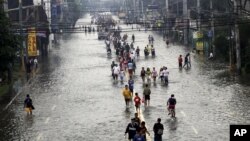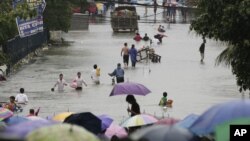MANILA — The Philippine weather service has lifted its storm warning for the capital, Manila. Flood waters that affected more than two-million people are now receding.
Three days of flooding in the capital region and immediate surrounding provinces followed nearly two weeks of non-stop rain caused by three cyclones in the Pacific.
The government has placed 20 cities and provinces under “a state of calamity,” which means they will receive national disaster funding.
Rescue
Civil defense chief Undersecretary Benito Ramos says teams are still working in “rescue mode” around the clock, but says some stranded residents are hampering efforts.
“The challenge[s] that we have here, number one: is the attitude of our people," explained Ramos."They refuse to evacuate if the flood is up to knee-deep, but when it is already up to waist [-deep] then they start texting [for help] even as far as Malacañan.”
Malacañan is the presidential palace and the president’s communications office is helping coordinate rescue efforts.
Social networks
The office and numerous other government agencies have been communicating via the social networking site Twitter. They have posted a rescue service through the site and given regular updates on where the heaviest rainfall is, which roads are passable and other brief messages.
Ramos says clearer communication and coordination with local and regional offices has improved management of this disaster, compared to three years ago.
In 2009, a typhoon caused the worst flooding the region had seen in 40 years, it was followed days later by another strong typhoon and both storms resulted in hundreds of deaths.
Price gouging
At that time, there were reports of price gouging of basic necessities. Some food items cost 50 times more than the regular price.
During the latest storms officials have kept close watch on prices. A 2010 amendment of the “state of calamity” designation means a price freeze automatically goes into effect.
After inspecting the largest markets in the capital, Trade Secretary Gregory Domingo says most goods were at the regular price, if not slightly lower.
“The government efforts now are much more organized," says Domingo. "There is much more planning in advance. We have better roads now than we did two years ago, so there is much more access. There is much less flooding.”
While Domingo says there was less flooding, there is speculation water levels remain high because garbage continues to clog drainage systems. Also officials of a Manila suburb say the river that experienced the worst of the flooding is heavily silted.
Domingo says in recent years government has increased spending and stepped up cleanup and drainage projects.
Three days of flooding in the capital region and immediate surrounding provinces followed nearly two weeks of non-stop rain caused by three cyclones in the Pacific.
The government has placed 20 cities and provinces under “a state of calamity,” which means they will receive national disaster funding.
Rescue
Civil defense chief Undersecretary Benito Ramos says teams are still working in “rescue mode” around the clock, but says some stranded residents are hampering efforts.
“The challenge[s] that we have here, number one: is the attitude of our people," explained Ramos."They refuse to evacuate if the flood is up to knee-deep, but when it is already up to waist [-deep] then they start texting [for help] even as far as Malacañan.”
Malacañan is the presidential palace and the president’s communications office is helping coordinate rescue efforts.
Social networks
The office and numerous other government agencies have been communicating via the social networking site Twitter. They have posted a rescue service through the site and given regular updates on where the heaviest rainfall is, which roads are passable and other brief messages.
Ramos says clearer communication and coordination with local and regional offices has improved management of this disaster, compared to three years ago.
In 2009, a typhoon caused the worst flooding the region had seen in 40 years, it was followed days later by another strong typhoon and both storms resulted in hundreds of deaths.
Price gouging
At that time, there were reports of price gouging of basic necessities. Some food items cost 50 times more than the regular price.
During the latest storms officials have kept close watch on prices. A 2010 amendment of the “state of calamity” designation means a price freeze automatically goes into effect.
After inspecting the largest markets in the capital, Trade Secretary Gregory Domingo says most goods were at the regular price, if not slightly lower.
“The government efforts now are much more organized," says Domingo. "There is much more planning in advance. We have better roads now than we did two years ago, so there is much more access. There is much less flooding.”
While Domingo says there was less flooding, there is speculation water levels remain high because garbage continues to clog drainage systems. Also officials of a Manila suburb say the river that experienced the worst of the flooding is heavily silted.
Domingo says in recent years government has increased spending and stepped up cleanup and drainage projects.









